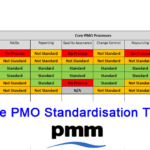In your work in project management offices (PMOs), you may already have worked with application tracking software. How to work with an ATS as a jobseeker may be easier if so, but there are some useful hints and tips that everyone can work with.
In a competitive job market, each position will get hundreds, sometimes thousands of applications. This is why more companies are turning to computer systems to help sift through the CVs that come through.
It’s estimated that more than 90% of US Fortune 500 companies use ATS, and its popularity is growing in the UK, Europe, and Asia. To help you understand what this means for you, we’re going to look at:
- What an ATS does
- The content that an ATS looks for
- How to optimise your PMO CV for an ATS
What is an ATS for PMO jobs?
Application tracking software has a range of functions – the one you’ll care about when looking for your next PMO job is how it processes your CV. Recruiters will program the system to scan all the applications it receives to scan for keywords, such as:
- Skills
- Competencies
- Qualifications
- Certifications
It’s worth knowing that these software systems also handle a range of other recruitment tasks, such as:
- Logging identity and criminal record check documents
- Communicating contracts to new hires
- Automating interview invitations and rejection emails
- Tracking probationary periods
They can also hold your CV on file so you may get a response for a different job at the same company in the future.
You might not know if the company or PMO you’re applying to uses ATS. It’s better to make your CV compatible with them – you don’t want to miss out on getting an interview because you assume a small company doesn’t have the system in place.
What does an ATS system look for on my PMO CV?
An ATS is going to scan your CV for information that’s relevant to the role you want. It’s down to the recruiter using it to get the most out of it – they will feed in the key terms that they expect to see on a CV.
The system will trawl your document for the words it’s been given. You’ll probably never know exactly what these words are, but you can be sure most of them will already be in the job description for the role you’re applying for.
This is why it’s becoming increasingly important to tailor your CV for each role you’re aiming for. Have the bare bones of your document, but always go through it and target your language to each company and each job.
Use industry standards on your CV. Take your job title – working at a start-up, you may have got a really cool and innovative job title, but it could really miss the mark for an ATS. If you’re role was the equivalent to a Project Management Office Leader, use that because it’s the language that will be searched for.
Add your qualifications logically. For example, when post-graduate education is a requirement, be sure to use the actual letters “MBA”. It’s more likely that this will be searched for rather than “Master’s in Business Administration”.
How do I optimise my PMO CV for an ATS system?
There are some general guidelines that will help you get your application through the software and onto the pile the recruiter will eventually look at. To get on to the recruiter’s desk:
- Use simple formatting – avoid coloured text or backgrounds, graphics, or tables because the system will struggle to scan them.
- Send the right file format – double-check the job advertisement, but if nothing is noted, go for a standard .docx or.pdf file type.
- Header and bullets – they will make your document clear and easy to scan through, and keep your headers simple such as “Education” and “Work Experience”- don’t reinvent the wheel.
- Stick to standard fonts – your CV needs to be legible for the computer system so Calibri, Arial, Helvetica, etc. are good standards to go for.
The take-home
It’s becoming increasingly common in job markets all over the world for companies of all sizes to use application tracking software. Knowing how to work with ATS job seeking software to get through the first hurdle of your application is simple when you understand what is being looked for.
Target your application, keep it looking simple and clear, and don’t use jargon that was specific to a previous employer – then let your skills and experience speak for themselves.
Complete guide to securing a PMO job eBook





